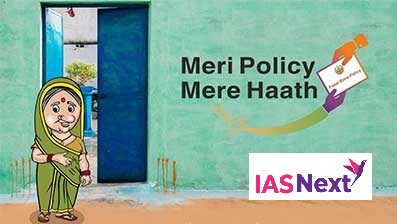CURRENT AFFAIRS
Get the most updated and recent current affair content on Padhaikaro.com
‘Meri Policy Mere Haath’ campaign
- IAS NEXT, Lucknow
- 22, Mar 2022

Reference News:-
‘Meri Policy Mere Haath’ campaign was launched recently in Hassan, Karnataka.
About the Campaign:
- The campaign is part of the Pradhan Mantri Fasal Bima Yojana.
- It is aimed at motivating all farmers in the country to insure their crops.
- Under this program, every farmer who has taken insurance under the Pradhan Mantri Fasal Bima Yojana (PMFBY) will get the policy documents at their doorstep.
Significance:
- The campaign empowers the farmers through crop insurance awareness and by bringing the insurance policy to their doorsteps.
- The campaign will also help in increasing the direct communication between the farmers and insurance companies.
About PMFBY:
The Pradhan Mantri Fasal Bima Yojana (PMFBY) has successfully entered its seventh year of implementation with the upcoming Kharif 2022 season, completing six years of its implementation since its announcement on 18 February 2016.
Performance of PMFBY:
- Till date, the scheme has insured over 30 crore farmer applications (5.5 crore farmer applications on year-on-year basis).
- Over the period of 5 years, more than 8.3 crore farmer applications have benefited from the scheme.
- Moreover, Rs.95,000 crores claims have been paid as against Rs. 20,000 crore farmers share.
About Pradhan Mantri Fasal Bima Yojana:
- It is in line with the One Nation – One Scheme theme- It replaced National Agricultural Insurance Scheme (NAIS) and Modified National Agricultural Insurance Scheme (MNAIS).
- Launched in 2016.
- Coverage: All food & oilseed crops and annual commercial/horticultural crops for which past yield data is available.
- Premium: The prescribed premium is 2% to be paid by farmers for all Kharif crops and 1.5% for all rabi crops. In the case of annual commercial and horticultural crops, the premium is 5%.
Objectives:
- To provide insurance coverage and financial support to the farmers in the event of failure of any of the notified crops as a result of natural calamities, pests & diseases.
- To stabilise the income of farmers to ensure their continuance in farming.
- To encourage farmers to adopt innovative and modern agricultural practices.
- To ensure flow of credit to the agriculture sector.
Coverage:
The Scheme covers all Food & Oilseeds crops and Annual Commercial/Horticultural Crops for which past yield data is available and for which requisite number of Crop Cutting Experiments (CCEs) are being conducted under General Crop Estimation Survey (GCES).
PMFBY to PMFBY 2.0 (overhauled PMFBY):
Completely Voluntary: It has been decided to make enrolment 100% voluntary for all farmers from 2020 Kharif.
- Limit to Central Subsidy: The Cabinet has decided to cap the Centre’s premium subsidy under these schemes for premium rates up to 30% for unirrigated areas/crops and 25% for irrigated areas/crops.
- More Flexibility to States: The government has given the flexibility to states/UTs to implement PMFBY and given them the option to select any number of additional risk covers/features like prevented sowing, localised calamity, mid-season adversity, and post-harvest losses.
- Penalising the Pendency: In the revamped PMFBY, a provision has been incorporated wherein if states don’t release their share before March 31 for the Kharif season and September 30 for rabi, they would not be allowed to participate in the scheme in subsequent seasons.
- Investing in ICE Activities: Insurance companies have to now spend 0.5% of the total premium collected on information, education and communication (IEC) activities.
Why is PMFBY criticised?
Since the beginning, farmers, especially from Maharashtra, have criticised the scheme for various reasons.
- One of the main arguments against it is that it helps insurance companies more than the farmers.
- Farm leaders claim insurance companies have made windfall gains at the behest of the public exchequer and farmers.
- Delayed payouts and denial of claims are other common complaints against insurance companies.
- The insurance companies were also blamed for not conducting enough crop cutting experiments (CCE), which measure the total loss experienced by the farmers.
Which states have withdrawn from the scheme?
Gujarat, Bihar, West Bengal, Andhra Pradesh, Telangana and Jharkhand have opted out of the scheme.